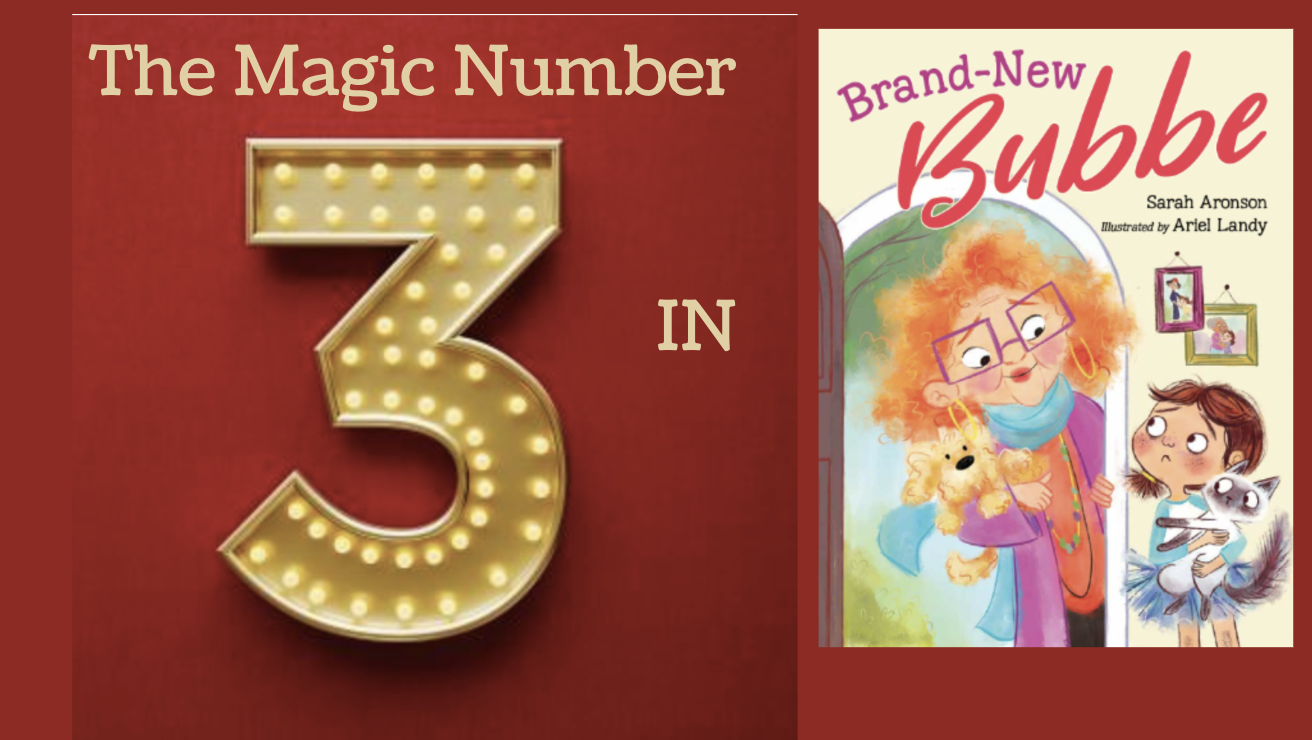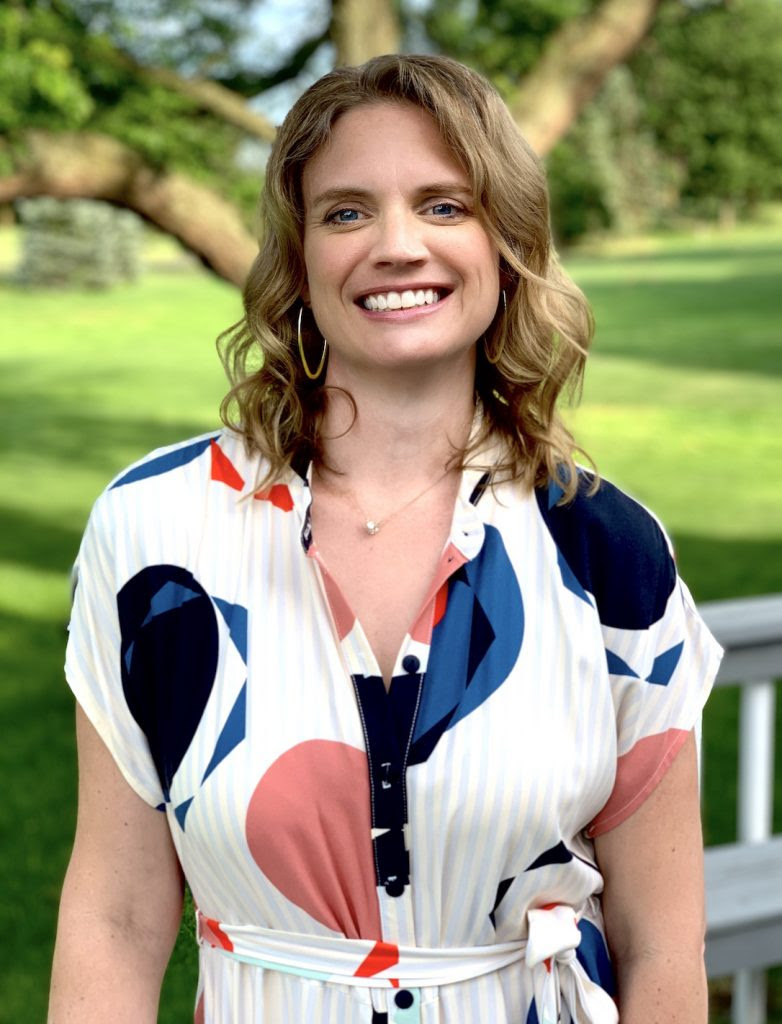craft review by Erin Nuttall
Numbers have power, magic, even. Not the abracadabra kind, but the kind that makes a reader sit up and pay attention even though they don’t know why. In the Hebrew Bible, the number seven is equated with wholeness or perfection. Similarly, in Western literature, the number three offers completeness that feels right in the reader’s mind. In his book, Writing Tools: 50 Essential Strategies for Every Writer, Roy Peter Clark describes the number three: “[T]hree provides a sense of the whole … the number three is greater than four. The mojo of three offers a greater sense of completeness than four or more. … Use one for power. Two for comparison, contrast. Three for completeness, wholeness, roundness.” Sarah Aronson understands the power of the number three as a literary device and uses it masterfully in her Picture Book, Brand New Bubbe.
Satisfying Three Act Structure
Like many stories, Brand New Bubbe is set up in three acts. In the first act, we meet our main character, Jillian, and Jillian meets her new stepdad’s mom–Bubbe. Bubbe brings a new energy into the house and worse, she brings a new soup–Matzo Ball. In the second act, Jillian begins a Bubbe protest, resisting all of Bubbe’s attempts at friendship. Mom gives Jillian a talking to —Jillian must give Bubbe a chance. Jillian worries that she will be rejecting her other grandmas by accepting her new grandma. In the third act, Jillian comes up with a plan to have all of her grandmas come over and each will make the soup she’s famous for. It starts out rocky but ends with Jillian realizing there is enough love–and soup–to go around. The three act structure is one that is familiar and comforting, the reader knows what to expect and can trust that the author will provide a well-rounded story.
Tricolons: What They Are and Why You Should Use Them
Aronson also makes excellent use of tricolons, which is a rhetorical device that uses three words or phrases in a sentence to add emphasis and rhythm, and to make it more memorable. It is frequently used in persuasive speeches and documents like when Lincoln said in his Gettysburg address, “A government of the people, by the people, and for the people.” Or when French revolutionaries shouted, ”Liberté! Egalité! Fraternité!” Or even the famous real estate motto: “Location! Location! Location!” These phrases all engage the audience in the same way. Each new idea (or repeated idea) adds to and strengthens those before it which reinforces the author’s themes. It also gives it a rhythm that helps people remember it. These are good reasons to use tricolons not only in picture books but in all writing you want to stand out or make memorable to the reader.
In Brand New Bubbe Aronson uses the power of three over and over to accentuate her themes and to add a lyrical cadence to her text. For example:
- Bubbe has three annoying traits
- Bubbe makes three failed attempts to win Jillian over
- Jillian says, “I’m not hungry,” “no thank you,” “please, may I be excused” when offered Bubbe’s soup
- Jillian has three grandmothers
- There are three different soups, one for each grandma
Tricolons in Action
Let’s look at one specific scene to see what Aronson does. Here she uses three sets of three to highlight the climax of Jillian welcoming her new Bubbe.
First, Jillian 1) stews, 2) simmers, and 3) has another bowl of soup while trying to come up with the plan. Aronson uses two short, alliterative words followed by a longer phrase the way Jefferson did in the Declaration of Independence “Life, liberty, and the pursuit of happiness.” It’s an extra potent version of a tricolon. The alliteration itself helps the text stand out and be memorable, but by changing the pattern in the third portion it plays with the reader’s expectations and surprises the reader thereby strengthening the significance of the sentence.
Second, Aronson uses three different descriptors to describe Jillian’s plan to invite all of her grandmas over to make soup: good, simple, and tasty. These three straightforward words do double duty by describing both Jillian’s plan and soup, quietly underlining Aronson’s themes.
Third, she repeats the same word—”very”—three times to emphasize the importance of each of the descriptors: very good, very simple, very tasty, emphasizing the greatness of the plan. By using the magic number three Aronson is able to pack a lot of punch in a few words.
Thanks to the magic number three in Aaronson’s Brand New Bubbe the text sparkles, the themes shine, and the reader is deeply engaged. Three is a powerful literary tool that can help any text do the same.
BONUS: Since Brand New Bubbe is a Picture Book, readers also get to enjoy the exciting, entertaining, and emotion-filled art of Ariel Landy, who also uses the magic number three in her craft. She frequently has three characters on a page, sets her scenes in a triangle shape, and puts three small, similar scenes on a page.
Now it’s YOUR turn!
You can use the magic number three whether you are writing a picture book, a chapter book, or a middle grade or young adult novel. It also works in fiction AND non-fiction.
- How many times does your main character try to solve their problem? Make it three!
- Look at a scene where you’re describing something or someone. Do you have three descriptors? Are you using alliteration? Are you surprising the reader with a longer phrase?
- Aronson uses “very” before each adjective when she’s describing Jillian’s plan. MLK repeated “I have a dream” three times at the beginning of each of his hopes. Can you add a repeated word or phrase to emphasize your theme?
Erin Nuttall holds an MFA in Writing for Children and Young Adults from Vermont College of Fine Arts and is an active member of SCBWI and ALAN. She lives outside of Chicago with her family where she writes stories for middle grade and young adult readers that offer a humorous take on friendship, identity, feminism, and romance.


COMMENTs:
0